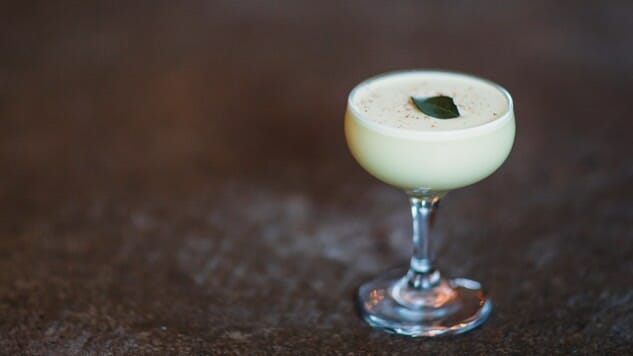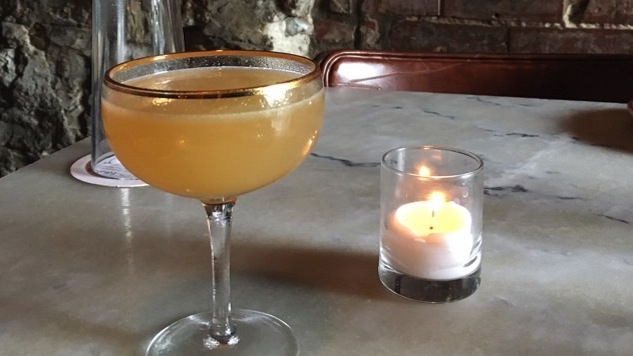
Thirsty? You’re in luck. In Paste’s drinking-and-traveling series, City in a Glass, we mix up a city’s signature swills and slide them down the bar to readers. Grab a stool. This round, in St. Louis, is on us.
In the mid-1800s St. Louis, Missouri, was one of the greatest cocktail cities in America. At the time, this port city on the Mississippi River was where everyone spent the night before going to the West. St. Louis was busy, modern and where the father of American mixology, Jerry Thomas, wrote the first cocktail book published in the U.S. But as the years passed, transportation methods changed and people began moving over St. Louis instead of passing through it. Jerry Thomas moved away, Anheuser-Busch Brewery grew in prominence and cocktails became a long-forgotten luxury of the past.
Today a small group of dedicated bartenders and bar owners is trying to bring back St. Louis’ cocktail reputation. The concentration of bars is fairly low (there are only about eight dedicated cocktail bars in the city), but the quality is high. “We’re starting to get a little more attention, but it’s still the Midwest,” bar owner Ted Kilgore says. “People don’t really think about it as having a cocktail scene. It irritates me.”
Bar manager David Greteman, who grew up in St. Louis, says they’re is pigeonholed for a myriad of things. “This is a major metropolitan city, but being from a state in the middle of the United States, I used to always get asked if I grew up on a farm,” he says. “There’s this collective mindset that there’s not much going on here. But who gives a f*** what anyone else thinks?”
In addition to fighting preconceived notions from people outside the city, bartenders also have to fight what they call the “Midwestern mindset.” In general Midwesterners want to taste the alcohol that they’re paying for and they want a fairly large portion (unlike in New York City, for example, where people will pay $15 for a thimbleful of a trendy, low-alcohol drink). There’s also a “no fuss no muss” attitude, as Greteman says. They don’t want drinks that seem fancy. They also want to come to a bar and get the same thing every time. If you change the menu on them, they will get upset. Predictability is a virtue. “That’s kind of a non-progressive way of thinking about it,” local barman Tim Wiggins says. “As a bar manager, you’re always trying to change the menu format, the drinks, the experience and give people something new.”
There is also a huge beer culture in St. Louis, so pushing spirits on locals—including many working class people who are employed by Anheuser-Busch—doesn’t always go over well. But that mindset is changing. Kilgore, who has lived in St. Louis for 10 years, says that five years ago he could buy all kinds or rare whiskeys and bourbons because no one in town was drinking them. “But when I opened my own place in 2013, all of a sudden I couldn’t buy them anymore,” he says. “Something had switched on and everyone started ordering Sazeracs, Old Fashioneds, Manhattans and any variation of those that we had.”
Now the city is seeing a rise in popularity of gin and rum-based drinks. Wiggins says it’s because tiki bars have boomed in nearby Chicago and the trend is slowly making its way to St. Louis. “There’s a two to three year gap between what’s cool there and what’s cool here,” he says. “As much as the Midwest hates to admit it, we’re always looking to the coasts to see what is happening.” Wiggins says it’s both bartenders and customers who are reading cocktail stories online and browsing Instagram for interesting cocktail photos. “It’s great because then when they see it at their local bar, they’re more accustomed to ordering it,” he says.
On this city drinks tour, we’re going to introduce you to three interesting St. Louis cocktails, show you where to find them and even how to replicate them at home.
![]()
1. Whiskey Kiss
Where to order: Planter’s House
 Photo courtesy of Planter’s House
Photo courtesy of Planter’s House
In the 1860s barman Jerry Thomas, the father of American mixology, worked at the opulent Planter’s House Hotel downtown. While working in St. Louis, Thomas completed his book Bar-Tender’s Guide or How to Mix Drinks, the first cocktail book published in the U.S. At the time Planter’s House had five restaurants and three bars and attracted famous guests such as author Charles Dickens and president Ulysses S. Grant. That hotel no longer exists, but in 2013 a new Planter’s House bar and restaurant opened to carry on its namesake’s unique legacy. “We celebrate the history of cocktails in St. Louis,” says co-owner Ted Kilgore. “Everything we do is rooted in the past.”
Kilgore’s menu focuses on the classics. For his Whiskey Kiss cocktail—a riff on a whiskey sour—he mixes a locally made whiskey with lime juice and chili and raspberry liqueurs. It’s spicy on the finish with a little touch of fruit, a timeless flavor that’s never gone out of style. “In the big cities you hear people talking about hospitality coming back to bartending. But I don’t see that it ever left in the Midwest,” Kilgore says. “You want to make the cocktail great, but more often than not the customer will not remember the drink they had; they’ll remember the experience and how you made them feel.”
Whiskey Kiss
1½ oz. Still 630 Rally Point Rye whiskey
½ oz. Ancho Reyes chili liqueur
½ oz. St. George Spirits Raspberry Liqueur
½ oz. Cocchi Aperitivo Americano Rosa
½ oz. lime juice
Lime wheel, for garnish
Raspberry, for garnish
Combine all ingredients (except garnish) plus ice in a cocktail shaker. Shake. Strain into a highball glass that contains a single, large ice cube. Garnish with a lime wheel and a raspberry.
![]()
2. In Bocca Al Lupo
Where to order: Taste
 Photo courtesy of Taste
Photo courtesy of Taste
To David Greteman, bar manager of Taste in the Central West End, one of the reasons why his warm, wood-filled bar is so special is because it push things on you. “All of this is subjective,” he says. “In larger cities they’re so focused on what a great menu they have that people feel obligated to like it. And if they don’t, they think they just don’t know enough about cocktails to enjoy it. They feel alienated from this ‘fancy’ concept.”
Even though Greteman thinks he has a great cocktail list—he’s got dozens of drinks incorporating homemade syrups and tinctures and curious spirits—he won’t ignore what someone may prefer to drink. Like Fireball? He’ll make you some from scratch. But if you want to try something new, he’d love to talk to you about something like the In Bocca Al Lupo (Italian for “good luck”). This drink includes Midwestern gin, Amaretto, lemon juice, cinnamon-chili syrup and bay leaf tincture, which rounds out the sharp sweetness of the Amaretto. “You shouldn’t be trying to impress people,” he says. “You should be trying to educate people and expand their horizons, which is good for the entire culture.”
In Bocca Al Lupo
1 oz. North Shore Mighty Gin
1 oz. Luxardo Amaretto
1 oz. lemon juice
½ oz. cinnamon syrup (recipe below)
10 drops Dirty Girl Farms bay leaf tincture
Luxardo Maraschino cherry, for garnish
Make cinnamon syrup: Break up six cinnamon sticks by hand. Pulse them in a spice grinder until they become the size of grains of rice. Set aside. Combine 1½ cups water and 3 cups white sugar in a saucepan. Heat slowly, stirring until sugar dissolves. Add the cinnamon plus 2 pinches chili flakes. Stir. Simmer on low for 10 minutes. Fine strain and allow the syrup to cool completely.
Make drink: Combine all ingredients (except garnish) plus ice in a cocktail shaker. Shake. Strain into a coupe. Garnish with a Maraschino cherry.
![]()
3. Golden State
Where to order: Retreat Gastropub
 Photo by J Elizabeth Photography
Photo by J Elizabeth Photography
Retreat Gastropub is one of the newest cocktail destinations in St. Louis. Open since October, the comfy and rustic bar provides an unusual getaway from the typical grind. Here, bar manager Tim Wiggins pushes out conceptual menus to keep people on their toes. “Certain cities on the coasts have the privilege of being super busy all the time and doing super weird and creative things and be accepted,” he says. “It’s a little bit harder in a place like St. Louis to come up with an innovative idea and make it stick.”
Nevertheless, Wiggins has had great luck incorporating some interesting spices in each of his drinks. “People don’t ask too many questions about the ingredients,” he says. “They see something, they get excited, and they order it. After our first nine months we said, ‘OK, we’re going to be a little bit more strange.’ And it’s been really well received.”
Take the Golden State cocktail for example. For this drink, Wiggins infuses a Kansas City-made gin with turmeric and ginger. Then he combines that with coconut cream and nutmeg and garnishes it with a curry leaf. “The leaf on top has this spicy nose that smells hot, almost like mustard greens,” he says. “But when you drink it, it’s very cooling and sweet and tart.” Despite it’s odd hot and cold flavor combo, the Golden State is one of the most popular drinks on the menu.
Golden State
1½ oz. turmeric- and ginger-infused J. Rieger & Co. Midwestern Dry Gin (recipe below)
½ oz. Pierre Ferrand Dry Curaçao
½ oz. lemon juice
1 oz. curried cream of coconut (recipe below)
Grated nutmeg, for garnish
Curry leaf, for garnish
Make infused gin: Combine 4 ounces Rishi turmeric and ginger loose-leaf tea and 1 750-mL bottle gin. Steep for six hours. Strain.
Make curried cream of coconut: Combine 10 ounces Rishi turmeric and ginger loose-leaf tea, 1 gram curry powder, 4 ounces sugar and 16 ounces cream of coconut in a blender. Blend.
Make drink: In a cocktail tin, combine all of the ingredients (except garnishes) plus ice. Shake. Strain into a coupe glass. Garnish with grated nutmeg and a curry leaf.
![]()
City in a Glass columnist Alyson Sheppard writes about travel and bars for Paste and Playboy. She currently resides in the great state of Texas.